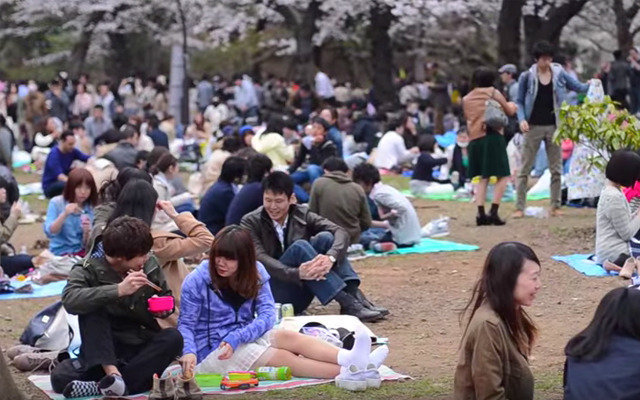- Tags:
- Cherry Blossoms / Hanami / Japan / Sakura / Spring
Related Article
-

New Deep-Green Tea Kit Kats Contain Double The Matcha Flavor
-

Japan’s Mister Donut Releases “Ronuts”–Doughnuts Served With A Slice Of Creamy Roll Cake On Top
-

Japanese Taiko Group Kodō’s Incredible Performance On Traditional Japanese Drums
-

Funabashiya Koyomi’s delightful sakura kuzumochi pudding is available for takeout
-

Master Japanese Painter’s Bird Artwork Turned Into Gorgeously Iced Cookies
-

Starbucks Japan Adds Fall Flavor With Golden Sweet Potato Frappuccino And Macchiato



Upon the arrival of spring each year, the Japanese flock to parks to sit under the blooming cherry blossom trees and have picnics with family, friends, and coworkers. It’s almost a peculiar sight — bright blue picnic sheets spread out under the soft pink curtain of sakura trees, with groups of people clumped together in the midst of it all.
YouTuber GLOBAL NOMADIC LIFE went to a park in Japan to capture a similar scene, giving the video the title “The Curious Culture In Japan.”
Under the premises of picnicking under sakura flowers, the tradition of hanami, or cherry blossom viewing, does not at all sound strange. But GLOBAL NOMADIC LIFE caught onto an interesting aspect of hanami culture, which they explain in the caption of the video:
It’s an intriguing point, but the nuance is a bit different from reality.
If a company decides to get together for hanami, it’s true that the new employees are bound to be entrusted with the task of getting a spot, which, in popular hanami spots, is quite difficult to do. So the better the spot they get, the more impressed the seniors will be, and hence the better image they might have of them in the future.
So how hard is it to get a good spot at a popular park? — Pretty hard, actually.
Devoted picnickers go to save the perfect spot hours before the actual event, and some even spend an entire night by themselves on the cold blue sheets so that they and their friends can enjoy the perfect afternoon sitting in the best location to view the cherry blossoms.
The sad thing is, once the party starts, it doesn’t actually seem like they’re there for the view — many get drunk, litter, and at times get into fights — and it looks like all they’re really enjoying is the idea of doing hanami, but not the actual hanami itself.
That’s not to say everyone acts this way. In fact, most people get together with their friends and family for a fun, peaceful lunch outdoors, and appreciate the sakura trees in all their delicate beauty.
But whatever the case, the tradition of hanami lies deep in the roots of Japanese culture, and the Japanese will continue to celebrate the sakura season every year.